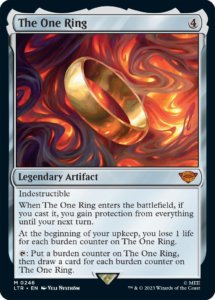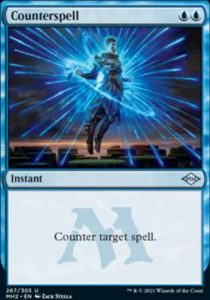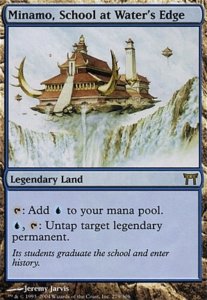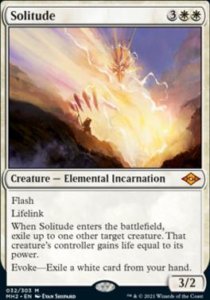If you are new here, don’t forget to check out our Discord Channel. it’s free for everyone!
Introduction to the post-LotR Control in Modern
We’re well into the post-LotR Modern at this point, and the metagame is starting to settle down a bit. For the expansion that was ridiculed as a Commander product by many, Lord of the Rings surely had a profound change on the Modern’s landscape. The most apt comparison in my opinion would be the first Modern Horizons set: a few extraordinarily powerful cards with significant impact, and a smattering of less powerful roleplayers. The most format-warping new card is The One Ring, and even though some people would argue that Orcish Bowmasters is a more powerful release, there’s no doubt in my mind that Middle-Earth’s most coveted artifact plays a far bigger part in shaping the environment of contemporary Modern.

The One Ring offers something that was hardly possible in the post-MH2: a continuous source of card advantage, similar to planeswalkers, that doesn’t share their weakness to one of the most played removal spells in Modern in Unholy Heat, and promises insurmountable advantage akin to Jace, the Mind Sculptor in his prime if you manage to untap with it once or twice. Granted, it comes with a fair bit of downside, but if you’re able to mitigate the life loss it forces upon you, you’ll be rewarded extremely handsomely.
The impact of The One Ring, Orcish Bowmasters and to a lesser extent other printings, caused quite a bit of uproar in the metagame. The most spectacular downfall has to be Hammer, going from one of the format mainstays for the last two years to being basically unplayable in the face of this new Modern. While there’s multitude of those shifts with varied degrees of significance, let’s focus on how The One Ring impacts the deckbuilding if you’re looking, like me, to cast the card Counterspell:
- With how much raw card advantage The One Ring provides, having other sources of it matters far less. My biggest issue with the Four Colour decks that were popular in the first couple of weeks after LotR release was precisely the overabundance of card advantage and the underutilisation of pitch cards that I’ll cover in a second
- Pitch cards get much, much better. When you’re so often drawing upwards of ten extra cards with the Ring, going down on cards to interact with your opponent is significantly less of a problem than it was before, and having a way to convert superfluous cards, especially at no mana expense, is extremely valuable
- The best way of dealing with the Ring is to make sure it never resolves in the first place. You can accomplish it by numerous means – discard, countermagic or simply winning the game before your opponent has a chance to play their four-drop all come to mind, depending on your strategy. As Counterspell and turn four goldfishes rarely pair well with each other, and discard is not ideal in a slower, more reactive shell, your primary way of preventing Rings from coming down will be countermagic, and preferably a lot of it.
- Ideally, you’ll never let your opponent resolve their almighty trinket, but sadly it won’t always be the case, so having a way to interact with an onboard Ring on either side of the board is quite important. Sometimes to prevent your opponent from running away with the game, sometimes to save yourself from dying, but you need to be able to remove unwanted jewellery with relative ease, and preferably with cards that are good on rate.
- Since The One Ring puts a fair amount of pressure on your life total, having ways to fend off opposing attacks and ideally gain some life is very welcome.

My first idea of a Ring deck was UR Control, strongly modelled after Murktide. I played it in Bologna at the beginning of June at the LMS event and did quite poorly, but learned a lot of valuable lessons in the process. UR had some promising aspects, like a painless manabase and cheap interaction, but the lack of lifegain or great ways of removing your own Rings other than playing another copy was an issue for sure. UW seemed to me like a natural stepping stone, as Solitude pairs extremely well with the Ring, and white offered an efficient and versatile removal suite.
Granted, UW is not the only plausible Ring deck, as both UB and Four Colour see a good amount of play. While I already shared some of my thoughts on Four Colour and I quickly dismissed it due to being quite horrendously misbuilt, UB piqued my interest since it’s a type of deck that I historically enjoyed a good amount and offered a similar, pitch-heavy approach to Ring decks that I value in UW. Ultimately I think that UW has a higher card quality and better tools (I can’t overstate how well Solitude plays with the Ring in my opinion), I wouldn’t be terribly surprised if at some point I end up playing UB over UW due to it being a better positioned deck.
My current list
You can find a downloadable copy of the decklist here.
Maindeck card choices
Let’s shortly go over my card choices:
Manabase
- 9 fetchlands (4 Flooded Strand and five other blue fetchlands): I’d like to play less lands that require you to pay life, but with Leyline Binding in the mix it’s paramount to have enough ways of getting Domain reasonably early on in the game. Some people opt to run one or two white fetchlands in addition to Strands for an improved access to basic Plains, but none of those are able to find both Breeding Pool and Steam Vents, which excludes them from considering for me
- 4 Shocklands (2 Hallowed Fountains, 1 Steam Vents and 1 Breeding Pool) and 6 basics (4 Islands and 2 Plains): Fairly self-explanatory: you need something to find with your fetchlands, and this split offers good access to all your colours at the minimal expense of your life total
- 2 Triomes (Raugrin Triome and Zagoth Triome): Technically I could’ve included Triomes in the above section, but there are different possibilities of mixing and matching your blue Triomes to get Domain and all of them have different upsides, so I’ve decided to elaborate. You have three different UWx Triomes and each of them have one corresponding blue Triome to complete Domain. First off the bat are Raffine’s Tower and Ketria Triome. This one’s easy – Raffine Tower can’t tap for neither red nor green to cast Omnath, so it’s a no-go for me. Then we have the stock option of Raugrin Triome and Zagoth Triome that I’m currently running. The biggest upside of Raugrin Triome is that it taps for both of your “good” colours and red as well, which is a bonus if you’re running Fire//Ice. Zagoth Triome is also a good “bad” Triome since it can cast Kaheera. Finally, there’s the pairing of Xander’s Lounge and Spara’s Headquarters. The idea behind it is that having a Triome that’s both red and black allows you to fetch your Fire land on first turn and satisfy the black requirement for Domain at the time, so you never have to fetch a tapped land again if you don’t want to. It’s a somewhat strong argument, but at the same time Xander’s Lounge can’t cast Kaheera, which kinda sucks, and if you only draw one fetchland then getting all red, blue and white at the same time is quite valuable, so after running this combination I went back to Raugrin + Zagoth Triomes
- Minamo, School at Water’s Edge and Otawara, Soaring City: you don’t get to play too many utility lands in a deck with Leyline Binding, so you need to make those you can’t include count. Luckily, both of those will easily make it worth your while. Minamo is insane with The One Ring and has some nice upside with Omnath, and Otawara is another way to bounce your own Ring and gives you an out to a wide array of problematic permanents to boot

Maindeck spells
- 4 Lorien Revealed: I’m gonna start with this one, as it’s something between a land and a spell. It’s very easy to not appreciate enough how big having this kind of effect is, and I expect Lorien Revealed to be a major player in multiple formats. I’d roughly estimate that I cycle it around 80 percent of the time, and the remaining twenty is somewhat evenly between casting and pitching. 27 virtual lands seems like a good amount to me for a deck that wants to make a land drop basically every turn of the game, and missing any of your first five lands is often a death sentence. Be smart, play enough lands
- 4 Solitude, 4 Leyline Binding, 3 Prismatic Ending: as I mentioned before, having efficient means of dealing with opposing threats is crucial for any Ring deck, and this suite of answers allow you to do so quite well. You’re probably tired listening to me constantly praising Solitude at this point, but it’s just that important in my opinion. Both Binding and Ending have some downsides, but they’re versatile enough to have targets in basically any matchup game one, and you can always trim or cut them completely if the matchup calls for it
- 2 Supreme Verdict: sweepers as a class of cards pair exceptionally well with the Ring, allowing you to regain the tempo you gave up by casting a four mana card with no immediate impact on the battlefield. On top of that, Supreme Verdict has the very important property of being both white and blue, so you can pitch it to whatever free spell you need at the moment, which makes it really hard for it to ever be truly useless
- 3 Fire//Ice: primarily played in Cascade decks, mostly Rhinos, as a way to bypass the mana value constraints of that strategy, Fire//Ice is somewhat underappreciated in Modern in my opinion, as it’s a versatile card with two relatively strong halves. If you can Ice your opponent’s land on a crucial turn, for example against Cascade when they’re about to play their third land, you can quite easily take the initiative (and I don’t mean the bullshit mechanic) back from your opponent. Fire is probably the best it’s ever been in Modern right now, as it cleanly deals with Orcish Bowmasters which can prove to be a bit of a nuisance otherwise. Even if not facing hordes of vengeful, card advantage-hating archers, you still have plenty of good targets for Fire, which comes in handy especially against decks where you want to kill a particular threat, but removal is not amazing against them overall – a good example of that can be Four Colour with Delighted Halfling. And if you ever get paired against a deck with multiple x/1s, Fire is close to the best removal spell you can have against them
- 4 Counterspell: it’s hard to say anything particularly groundbreaking about a card as iconic as Counterspell: it just does what it does well, and offers you a broad answer against the vast majority of threats you can possibly face no questions asked. Surely, sometimes it won’t line up well against your opponent’s curve, or their uncounterable threat via Delighted Halfling or Cavern of Souls, but you have plenty of play against those cards and the versatility of Counterspell definitely earns it four spots in the maindeck
- 2 Force of Negation, 2 Subtlety: having a good amount of free countermagic alongside The One Ring is important, as it’s your main way of pulling ahead on tempo after resolving your Ring, especially against decks that don’t care about Supreme Verdict. I like having a bunch of copies of both of those cards in my 75, and the particular split between the maindeck and the sideboard is very dependent on the expected metagame. In an open field, I like running 2 of each in the maindeck with additional copies in the sideboard, but if your metagame is skewer in the direction where either Force or Subtlety is significantly better than the other, feel free to run a different configuration
- 2 Omnath, Locus of Creation: with the mana already skewed towards casting Leyline Binding, it’s quite trivial to add one more shockland and have it support Omnath. Granted, you won’t always be able to cast it, and you’ll get a few of those ugly double Island Omnath openings, but I can assure you, the reward is well worth the risk (especially since you can pitch Omnath to any of your free spells). Few cards synergise with the Ring as well as Omnath, both as a way to pad your dwindling life total and a burst of mana more or less each turn, allowing you to use all those extra cards. Few extra wincons are also quite welcome, as the Rings that took the place of walkers are excellent at everything but actually getting you over the finish line. Having a four drop in your deck can be quite clunky sometimes, but I wholeheartedly recommend running at least two, if not three copies of Omnath in your UW deck at the moment
- 4 The One Ring: the heart of the deck and the reason why control is a competitive archetype in contemporary Modern. With such a powerful card advantage engine, all you need to do is to fill your deck with enough cheap interaction to get yourself in the position of casting it, and once it resolves you’ll usually be able to run away with the game in a span of one or two turns. Keep in mind that there are few cards that can interact with the card drawing ability at instant speed, like Orcish Bowmasters, as well as removal like Leyline Binding, so keep those in mind while planning your activations. Another aspect of playing with the Ring that wasn’t instantly apparent to me was not auto-drawing with the Ring every turn. If you already have a full hand, it’s often not worth getting four or five more cards just to end up discarding a bunch of stuff only to find yourself unable to finish the game afterwards. It mostly comes up against decks heavy on removal, and I’d overall say that if you feel like you need to draw something in particular then go for it and discard to hand size if necessary. All I’m trying to say is that you shouldn’t autopilot your Ring activations (or anything in Magic I guess)
- 3 Teferi, Time Raveler: Teferi is the lone planeswalker remaining in the deck, mostly because he does many small-ish things well enough to end up being an impactful card in most matchups. Having two colours for pitching, bouncing Rings on either side of the board, getting instant speed Verdicts and making it all that much harder for your opponents to play the game before even taking shutting down Cascade and similar things into consideration, all sums up to a pretty great card that I’m happy to include in my deck

Sideboard
- 1 Kaheera, the Orphanguard: Companion is still as broken of a mechanic as ever, and Kaheera is actually a relevant piece of cardboard fairly often. It pitches to Solitude and empowers your creatures in a meaningful way. You can consider running some sideboard cards that aren’t compatible with Kaheera if they are particularly powerful in any given matchup, but for now I haven’t found any such card
- 2 Force of Negation, 1 Dovin’s Veto, 1 Spell Pierce: this is my preferred split of counterspells at the moment. Force of Negation synergises extremely well with The One Ring, so I like having a full playset for matchups where it’s good. Both Veto and Pierce have different upsides, and if you don’t expect to face many Wrenn and Sixes and Lava Spikes you can probably cut a Pierce for another Veto
- 2 Stern Scolding: even though it’s a counterspell and could technically be included in the above section, I wanted to cover it separately as it’s much more of a surgical tool against certain matchups than a broad answer akin to Force or Pierce. Two biggest reasons to run Scolding are Yawgmoth and Scam, as it answers basically any threat both of those decks can throw at you (with a few exceptions of course) for a mere one mana. There are other less popular matchups where Scolding is reasonable, such as Scales or Hammer, but being a great card against two of the most popular decks in the format is enough to earn a couple spots in the board
- 1 Supreme Verdict, 1 Subtlety, 1 Prismatic Ending: I just wanted to have access to more copies of those cards over what I have in the maindeck in matchups where they’re good. You can mix and match between maindeck and the sideboard, but those numbers are what I’m comfortable with for now
- 2 Veil of Summer: I’m not the biggest fan of splashing for Veil of Summer, as it’s not trivial to get green mana on turn one or two which is where Veil shines the most against Scam and to some extent Living End, but with the introduction of the UB Ring deck, I think it’s good to have a card that’s extremely punishing for them even on turn ten or so, especially with a lot of haymakers you can protect well with Veil. Overall, I don’t think that it’s a card worth running if you don’t expect to face a bunch of UB
- 1 Sunset Revelry: while Revelry is a narrow card (basically only coming in against Burn), the value over replacement that it offers in that matchup is so high that I like having at least one copy in my sideboard, especially since Burn is getting somewhat popular once again
- 2 Rest in Peace: I like Rest in Peace more than Chalice against Living End, as with four Forces you have a good amount of play against their fast starts, and Rest in Peace, unlike Chalice, undoes a good amount of their work should they cycle into an answer. It’s also a good card against Combo Breach, which is a somewhat problematic matchup for the deck
This list of cards is by no means exhaustive, and depending on the metagame, there are various other options you can run. Some of the things I’ve tried before and deemed not good or useful enough for various reasons:
- Unmoored Ego and Crumble to Dust against Tron. Ego is a bit more versatile than Crumble, even if possibly less effective, but both of them get hosed by Warping Wail and won’t bolster your win percentage significantly in my opinion. I don’t think this deck can reasonably support Blood Moon, but Alpine Moon could be a consideration
- Dress Down, March of Otherworldly Light, Wear//Tear and other anti-Saga cards. If some Saga deck that gives you fits becomes more popular (like Combo Breach), I can see adding some of those again. For now, I don’t think such measures are necessary
- Narset, Parter of Veils. This was supposed to be my anti-Ring card, but I think that the deck doesn’t need much help against non-UB Ring decks, and Narset isn’t particularly great against Orcish Bowmasters, Sauron’s Ransom and Subtlety
That’s all I had to say today, thanks for reading and be sure to check out my sideboard guide once it releases over the next few days if you’re interested in trying out the deck yourself.
